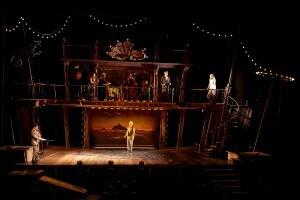- May 13, 2014
- By Lauren Brown
Shakespeare’s plays, with their universal themes of love, family and power, have been re-imagined into everything from “West Side Story” to “The Lion King.”
Fully realizing the Bard’s visions of magic is even more challenging, but here’s a good place to start: bringing together the head-turning magic of Teller, from the well-known duo Penn & Teller, with the music by Tom Waits and an inhuman creature with extra legs and arms.
From this bag of tricks comes a unique production of “The Tempest,” which opened May 10 in Cambridge, Mass., in great part by the efforts of School of Theatre, Dance, and Performance Studies faculty members Aaron Posner and Dan Conway.
Posner, a nationally known playwright and director who won three Helen Hayes Awards in D.C. just last month, says he and his co-director, Teller, set out to create “the most engaging, most enjoyable, most relentlessly entertaining, most accessible ‘Tempest’ that’s ever been done.” He says it aims to please anyone—from an 8-year-old child to a Shakespeare scholar.
Of course, the tale of the exiled magician Prospero provides plenty of material: a revenge tale, a father-daughter story, a romance.

“We’ve taken every cue from Shakespeare, trying to serve the story that he wrote,” Posner says. “But we feel like we wrote a big, wide, wildly entertaining play with a lot of opportunities for spectacle built into the show.”
The pair previously worked together on productions of “A Midsummer Night’s Dream” and “Macbeth,” other Shakespeare plays with magical elements that appealed to Teller.
In an interview with the American Repertory Theater (ART), which is co-producing the show with the Smith Center for the Performing Arts in Las Vegas, Teller no longer plays the silent partner of his magic act. He explains that in the 17th century, actors had to tiptoe across stage to deposit items that were supposed to “appear,” and skitter offstage with them to show they’d “vanished.”
ART’s contemporary production, he says, actually does those things, such as a trick that has a feast instantly cover a banquet table on stage.
“We thought it would be very interesting to put the audience in the same position of amazement that the other characters are (in),” Teller says.
He also had an unexpected vision for the play’s setting, and the first call he and Posner made was to Conway. The associate professor of design at Maryland was their set designer on an acclaimed 2008 production of “Macbeth” at D.C.’s Folger Theatre.
A historian of magic, Teller was intrigued by a 1930s traveling magician named Willard the Wizard, and wanted the music and scenery to reflect the Dust Bowl era—“a shipwrecked dead carnival.”
He had to imagine a set that reflected all that, while supporting the original story of shipwrecked aristocrats washing ashore on Prospero’s mysterious island for him to manipulate. Plus, it had to accommodate a four-piece live band, modern dancers from the Connecticut-based company Pilobolus, and the complex practical requirements of executing vaudevillian magic tricks. (Prospero, for example, levitates his daughter Miranda and spins the head of the spirit Ariel 360 degrees.)
Conway recruited two of his third-year master’s students in design, Andrew Cohen and Paige Hathaway, to help conduct research, design and build models for the set and plan props. Cohen spent 10 days in Las Vegas before the play’s debut there to observe rehearsals and create and improve props.
“From start to finish, it was a really great experience because of the sheer size of it,” he says. “It allowed me to see what exactly is required to execute a show this big.”
To evoke the 1930s era, they had a custom-built tent installed on the grounds of the performing arts center, complete with electricity, heat and air conditioning. Nevada’s desert windstorms were frequent enough to make the lights and scenery sway and create an unintended element of danger.
More officially, the spectacle also includes the antics of the Pilobolus dancers, including two who never separate on stage in order to portray the extra-limbed villain Caliban, as well as a new score by folk singer-songwriter Waits and Kathleen Brennan, his wife and collaborator.
“The Tempest” ran April 5-13 before moving to ART’s home in Cambridge through June 15. (The tent, however, didn’t travel cross-country, and the elaborate set is now on a stage.) It will then shift back west, to Orange County, Calif.
Posner hopes the show, which has been featured in “Broadway World” and American Theatermagazine, heads to additional venues after that.
“The truth is, this is the most exciting, the hardest, the most challenging—and the most thrilling production I’ve ever been a part of,” he says.
Click to view additional images from the production.









